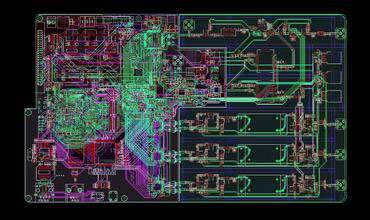
Signal launch is a term often used to describe how the signal is introduced to the PCB. Many times the signal may be coming to the PCB by a cable and the transition from the cable to the PCB is done through a connector. In the case of RF applications, the cable is typically coaxial and the connector has the same coaxial configuration. The orientation of the electric fields in the connector are different than the orientation of the electric fields in the PCB.
The PCB is a planar structure, and typically the electric fields are perpendicular to the copper planes within the PCB. The fields are generally described as a rectangular coordinate system. In the case of a coaxial structure, the electrical fields are between a center conductor and the surrounding ground sheath. The electric fields are typically described in a cylindrical coordinate system. The interface where the coaxial connector meets the PCB, sometimes referred to as the signal launch, will cause the electric fields to transition from cylindrical orientation to rectangular orientation and this transition can cause many signal integrity issues.
In general, at microwave frequencies well below 3–5 GHz, signal launch is simple with few critical issues arising from time to time. In contrast, signal launch is quite critical as we begin to operate at higher frequencies or high bit data rates. At these higher frequencies/data rates, the signal wavelength is small enough that the connector launch/circuit board trace transition physical dimensions will impact the wave properties as it changes from radial to planar distribution. For example, at 1 GHz the wavelength of the signal on a double-sided PCB using material with a dielectric constant (Dk) of 3 is about 6.8 inches (173 mm). When the signal launch transition is 0.3 inches, the physical dimension is well below 1/8 wavelength (~0.8 inches) which will have an insignificant effect on electromagnetic fields. A general rule of thumb is that a physical dimension at the transition which is 1/8 wavelength or larger can cause signal launch disturbances.
However, for this same example operating at 3 GHz or 5 GHz, the 1/8 wavelength is 2.3 and 1.4 inches, respectively. The 0.3 inch transition is now close to 1/8 to 1/4 inches in dimension, which will have repercussions in the electromagnetic fields at this transition and would need to be compensated for by the RF engineer.
There are several things that can be done regarding the PCB and connector design to minimize the signal launch issue. One of the simplest ways is to use a smaller connector. In the RF industry, there are many different types of connectors and each type has a range of frequencies capable of being used with minimal electromagnetic field disturbances. The range of frequencies at which these connectors are rated are usually based on the connector not having resonances that interfere with the signal integrity, but in general, higher frequency-rated connectors are smaller.